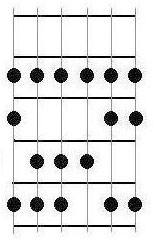Phrygian Mode
Phrygian Mode

The Phrygian mode can refer to three different musical modes: the ancient Greek tonos or harmonia sometimes called Phrygian, formed on a particular set octave species or scales; the Medieval Phrygian mode, and the modern conception of the Phrygian mode as a diatonic scale, based on the latter. It is also known in Arabic and in the Middle East as the Kurd mode.
Ancient Greek Phrygian mode
The Phrygian tonos or harmonia is named after the ancient kingdom of Phrygia in Anatolia. The octave species (scale) underlying the ancient-Greek Phrygian tonos (in its diatonic genus) corresponds to the medieval and modern Dorian mode.
In Greek music theory, the harmonia given this name was based on a tonos, in turn based on a scale or octave species built from a tetrachord which, in its diatonic genus, consisted of a series of rising intervals of a whole tone, followed by a semitone, followed by a whole tone (in the chromatic genus, this was a minor third followed by two semitones, and in the enharmonic, a major third and two quarter tones). An octave species was then built upon two of these tetrachords separated by a whole tone. This is equivalent to playing all the white notes on a piano keyboard from D to D:
This scale, combined with a set of characteristic melodic behaviours and associated ethoi, constituted the harmonia which was given the ethnic name "Phrygian", after the "unbounded, ecstatic peoples of the wild, mountainous regions of the Anatolian highlands (Solomon 1984, 249). This ethnic name was also confusingly applied by theorists such as Cleonides to one of thirteen chromatic transposition levels, regardless of the intervallic makup of the scale (Solomon 1984, 244–46).
Medieval Phrygian mode
The early Catholic church developed a system of eight musical modes that medieval music scholars gave names drawn from the ones used to describe the ancient Greek harmoniai. The name "Phrygian" was applied to the third of these eight church modes, the authentic mode on E, described as the diatonic octave extending from E to the E an octave higher and divided at B, therefore beginning with a semitone-tone-tone-tone pentachord, followed by a semitone-tone-tone tetrachord (Powers 2001): E F G A B + B C D E
The ambitus of this mode extended one tone lower, to D. The sixth degree, C, which is the tenor of the corresponding third psalm tone, was regarded by most theorists as the most important note after the final, though the fifteenth-century theorist Johannes Tinctoris implied that the fourth degree, A, could be so regarded instead (Powers 2001).
Placing the two tetrachords together, and the single tone at bottom of the scale produces the Hypophrygian mode (below Phrygian):
